|
1.
CENTRAL AND WEST AFRICA
Production levels generally remain low
The African timber sector enters the final months of 2025
under heavy pressure from both domestic financial
challenges and weak international demand. Across the
region production levels remain low while prices are
largely flat due to sluggish export orders.
Global demand remains muted, China’s continued
slowdown, competition from Brazilian softwoods and a
flat European market are collectively restricting export
growth for African producers.
Producer perceptions of international demand
China remains the most critical weak link in global
tropical timber demand. The Chinese government has not
announced any new stimulus measures for the housing and
construction sectors leaving the market flat. Import
volumes of Okoume and Okan remain sharply reduced as
the volume of landed stocks is said to be high.
Demand in India is seen as stable with steady imports of
peeled veneer and Padouk sawnwood. While demand is
consistent prices are under pressure due to competition
from lower-cost Southeast Asian suppliers.
Phillipine imports from African suppliers have slowed
considerably. It has been suggested that buyers are seeing
competitive pressure from Indonesian suppliers offering
product at attractive prices.
Middle East markets are under increasing competitive
strain from Brazilian kiln-dried sawn pine effectively
displacing several West African hardwood species.
The European market remains unchanged and subdued.
Demand is limited to niche certified species, with little
sign of recovery in the short term. Buyers are operating
mainly on replacement-level purchasing, avoiding
speculative contracts.
Gabon
Analysts report the situation in Gabon has become
increasingly tense and financially strained. The Forestry
Ministry and the Presidency are actively addressing unpaid
taxes in the forestry sector. Some major operators are
reportedly unable to pay the 40% settlement demanded on
outstanding arrears of over 5 billion FCFA. This has led to
suspension of operations and to layoffs. There is a mood
of uncertainty in the timber industry.
Adding to the strain the 2026 Finance Law is expected to
introduce further tax increases. These will come at a time
when the sector needs relief and liquidity support.
Producers are calling the situation a “disaster,” and
investment confidence is fading rapidly.
A Presidential Task Force has been established to audit
and enforce financial compliance across the forestry
sector. It has been reported that the first round of
inspections revealed large-scale arrears on land taxes,
transfer charges and social welfare contributions. Reports
indicate that some companies have negotiated releases
from shutdowns after partial payments while others are
resorting to temporary layoffs, paying only 30% of salaries
during suspension periods.
With ongoing rains, forest accessibility remains limited.
Harvesting continues at low levels and electricity
disruptions persist affecting commercial operations.
Export activity is slow and Okoume stocks at Nkok remain
high.
The government continues to promote 3rd and 4th level
transformation targeting plywood and furniture production
initially for domestic consumption. However, operators
say it will be difficult to be competitive in furniture
manufacturing due to very low priced imports.
Cameroon
October saw heavy rainfall in Cameroon which slowed
operational activity as roads become increasingly
impassable, however, mill stocks are said to be sufficient.
Flooding in northern Cameroon and along the Chad border
has caused severe damage to housing and transport
infrastructure.
Transport on laterite roads is controlled when the rain pose
a risk, traffic is prohibited during rainfall to prevent
further deterioration. This continues to delay timber
transport from the interior regions. Rail transport remains
operational and stable with no major disruptions reported.
Sawmills continue to operate but at reduced levels due to
lower demand and challenging logistics. Many operators
are limiting milling to satisfy only existing contracts.
Operations in Douala and Kribi Ports are functioning
normally, though vessel congestion occasionally delays
berthing. Container availability is reported as satisfactory
and there are no major logistical issues at the ports.
No major regulatory changes were introduced in October
but operators report delays in permit renewals, inspection
processing and processing of customs documentation.
CITES compliance checks and EUTR-related
documentation requests remain strict.
Overall, export prices in Cameroon remain stable but
export volumes have declined as buyers avoid long-term
contracts.
The recent re-election of President Paul Biya has not yet
translated into market confidence with operators and
investors largely holding back on new commitments
pending clearer signals from the government.
Republic of the Congo
The Congo has for months been preparing for presidential
elections in 2026 and the business climate is said to be
cautious with operators are holding back on capital
investments and expansion plans until after the election.
Unlike Gabon and Cameroon, harvesting in the Congo
continues despite seasonal rains. Export volumes are
moderate, with operators increasingly focusing on
European species as Chinese demand remains weak.
Rail operations are said to be stable but the overall
logistics network is under stress due to heavy port
congestion.
The Port of Pointe-Noire, Congo’s main timber export
hub, is experiencing a severe backlog of vessels. Shipping
delays are increasing costs significantly. Authorities have
acknowledged that port expansion is urgently required and
discussions are ongoing with Chinese partners to finance
an extension project. Despite congestion, container
availability remains sufficient and exports continue, albeit
at slower turnover rates.
Congo’s forestry sector remains one of the most structured
and controlled in the region and government agencies are
strictly enforcing compliance with CITES and EU
regulations.
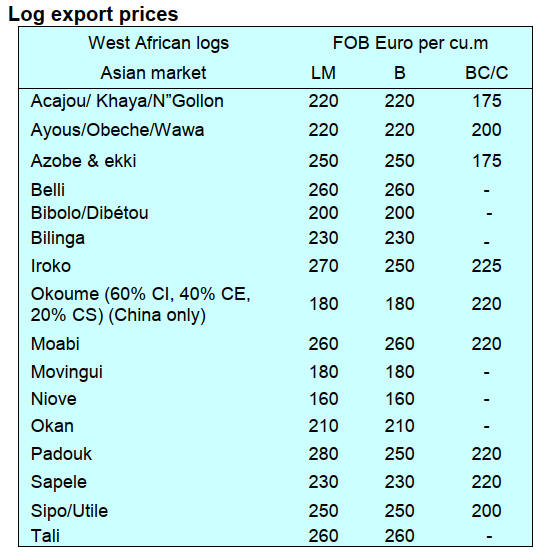
Through the eyes of industry
The latest GTI report lists the challenges identified by the
private sector in the Republic of Congo and Gabon.
See: https://www.itto-
ggsc.org/static/upload/file/20251022/1761099830162631.pdf
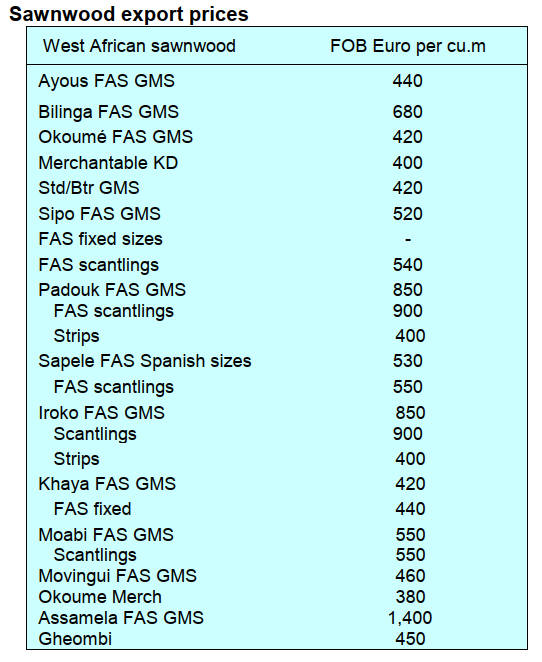
2.
GHANA
Small-scale mining licenses revoked
The Minister for Lands and Natural Resources (MLNR),
Emmanuel Armah-Kofi Buah, has revoked 278 small-
scale mining licenses across the country over regulatory
breaches and the expiration of operating permits.
According to Paa Kwesi Schandorf, the Media Relations
Officer at the Ministry, the decision forms part of the
Ministry’s ongoing efforts to enforce regulations in
Ghana’s small-scale mining sector.
The revoked licenses include those belonging to operators
who failed to comply with key environmental and safety
standards or who continued operations after their permits
had expired.
The move underscores the Minister’s commitment to
enforcing discipline and accountability in the small-scale
mining industry which has been plagued by illegal
operations and environmental degradation in recent years.
Since assuming office the Minister has initiated a
coordinated multi-pronged approach including the setting
up of the Blue Water Guards and National Anti illegal
Mining Operations Secretariat (NAIMOS) to combat
illegal mining and environmental destruction. He has
called for a concerted and shared effort from civil society,
the private sector and all Ghanaians to help protect the
country’s remaining forest resources and water bodies
from further depletion.
Meanwhile, the office of the Attorney-General is currently
prosecuting over 1,500 cases of illegal mining, commonly
known as galamsey and to expedite these legal processes,.
See: https://www.myjoyonline.com/lands-minister-revokes-278-
small-scale-mining-licenses-over-regulatory-breaches/
Strengthen collaboration - advisory board observes
operations of the Commission
The Ministerial Advisory Board to the Ministry of Lands
and Natural Resources (MLNR) paid a working visit to the
Forestry Commission (FC) to familiarise itself with the
operations of the Commission and strengthen
collaboration between the Ministry and its key
implementing agency.
The visiting team comprised members of the Board, the
Secretary and support staff. They were received by the
Chairman of the FC Board, Professor Martin Oteng-
Ababio, along with the Acting Chief Executive, Dr. Hugh
C. A. Brown, his deputies and members of the Executive
Management Team.
In his welcoming address, Professor Oteng-Ababio
appealed to the Advisory Board for logistical support to
help the Commission effectively address its operational
challenges to deliver on its mandate. These included
security threats posed by heavily armed illegal miners,
insufficient funding for reclamation and reforestation and
the lengthy judicial processes for prosecuting forest
offenders.
Dr. Brown highlighted some key achievements of the
Commission in 2025. This included efforts to restore
degraded landscapes, of which 9,707 hectares of
plantations had been established so far. The reclamation of
nine forest reserves from illegal miners resulted in the
seizure of 190 excavators, 16 vehicles and the arrest of
345 suspects.
Responding on behalf of the visiting delegation, Mr. Israel
Ackah, Co-Chair of the Advisory Board, explained that
the purpose of the visit was to foster meaningful
engagement between the Ministry and the agencies under
its supervision. He emphasised the Board’s commitment to
learning about the Commission’s work and offering its full
cooperation to support the government’s broader
environmental vision.
See: https://fcghana.org/ministerial-advisory-board-pays-
familiarisation-visit-to-fc/
Ghana’s wood product market performance – Asia
tops
Asia continent continued to maintain its dominance as
Ghana’s largest market for wood products for the period
January to August 2025. Total exports to Asian markets
for the 8 month period accounted 66% (95,075 cu.m)
valued at Eur36.05 million according to Timber Industry
Development Board (TIDD) data source. However, this
represented a decrease of 24,131 cu.m in volume and
Eur10.08 million in value when compared to the same
period in 2024.

Aside from the shipments of wood products to Asia the
share of Ghana’s remaining wood product exports for the
first eight months of this year went to Europe (16%),
Africa (10%), America (5%) and Middle East (3%).
Ghana’s main importing countries in Europe were Italy,
France, Germany, the UK, Belgium, Spain, Ireland and the
Netherlands while African market destinations included
Egypt, Morocco, and South Africa and the ECOWAS sub-
region.
Wood products export to Asian markets included air and
kiln dried sawnwood, billets, sliced veneer and
mouldings. The species exported included Teak, Denya,
Wawa, Koto / Kyere, Papao / Apa, Cedrela, Kaku / Ekki /
Azobe, Asanfina / Anigre, Gmelina and Ananta.
Local currency erases losses recorded in Q3 2025
Available data from Commercial Banks showed that the
Ghana Cedi depreciated by about 14% in the third quarter
of 2025. But the currency sustained a “good run” against
the US dollar in the first half of October 2025, which
helped erase the local currency’s losses posted in the third
quarter of the year. The Cedi had earlier recorded
appreciation by more than 40% at the end of July 2025 to
about 21% by the end of September.
Bank analysts have attributed the recent performance of
the Cedi to the Bank of Ghana’s new forex market
interventions and monetary policy measures that have
improved dollar supply and strengthened enforcement of
foreign exchange regulations. The CEO of Ghana
Association of Banks has described the currency’s
performance as a policy shift that has enhanced market
efficiency.
The stability of the local currency is also a welcome
development to local industries, which will now require
fewer Cedis to purchase the same amount of foreign
currency to secure raw materials and machinery parts for
their production.
See: https://www.myjoyonline.com/cedi-erases-q3-losses-
recorded-in-2025-posts-37-year-to-date-appreciation-against-
dollar/
Informal cross-border trade at GH¢7.4 biln in the final
quarter of 2024
According to the Ghana Statistical Service (GSS) survey
informal cross-border trade between Ghana and its three
neighbouring countries reached GH¢7 bil. in the fourth
quarter of 2024 (Q4 2024), representing 4% of the
country’s total trade for the period.
The report revealed that informal trade continues to
dominate the country’s commerce with its immediate
neighbours, Togo, Burkina Faso and Côte d’Ivoire. The
volume of informal trade during the period accounted for
61% of total trade with Togo, 56% with Côte d’Ivoire and
37% with Burkina Faso.
The formal trade still dwarfs informal trade overall with
formal trade valued at GH¢165.3 bil. compared to GH¢7.4
bil. in informal trade during the quarter.
See:
https://www.statsghana.gov.gh/headlines.php?slidelocks=ODA0
OTM4MzIxNC44MzI1/headlines/05r1nrn496
and
https://thebftonline.com/2025/10/23/informal-cross-border-trade-
hits-gh%C2%A27-4bn-in-q4-2024/
 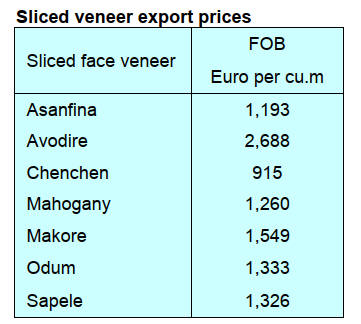
Through the eyes of industry
The latest GTI report lists the challenges identified by the
private sector in Ghana.
See: https://www.itto-
ggsc.org/static/upload/file/20251022/1761099830162631.pdf
3. MALAYSIA
Difficult to find alternative markets in the short term
Malaysia’s furniture industry cannot easily cushion the
impact of the latest US tariffs by selling more to other
markets, at least not in the short term, say manufacturers.
Muar Furniture Association (MFA) president, Steve Ong,
said no other export market comes close to the United
States in terms of market size and demand for Malaysian
wooden furniture. (see table) Johor, particularly Muar,
produces the bulk of Malaysian wooden furniture. Trying
to reduce reliance on the US by growing sales in other
countries or finding new markets would need time, along
with government support and assistance, he added.
The United States remains the largest market. Singapore,
the United Kingdom and Japan are also Malaysia’s key
export markets but none come close to the scale and
consistency of demand seen from the United States, said
Ong. From January to August wooden furniture exports
dropped by around 3% year on year but shipments to the
United States moved in the opposite direction, rising 2%
reflecting front loading of exports in the early part of the
period.
According to data from the US Census Bureau Malaysia
was the fifth largest supplier of wooden furniture to the
United States last year behind Vietnam (US$6.27 bil),
China (US$1.88 bil), Canada (US$1.5 bil) and Mexico
(US$1.06 bil).
The MFA president said the new tariffs were expected to
dampen demand with local furniture manufacturers likely
to face pressure to absorb part of the cost to maintain
competitiveness. “Besides tariffs, we are also dealing with
rising domestic costs such as higher Sales and Service Tax
(SST), foreign labour EPF (Malaysian provident fund for
retirement) contributions and electricity rates, all of which
could further weaken our international competitiveness, he
added.
Malaysian Furniture Council (MFC) president, Desmond
Tan, said he was disappointed with the tariffs as Malaysia
and the United States shared a mutually dependent
economic relationship. He said investment, Trade and
Industry Ministry officials were currently in talks with the
United States to seek tariff exemptions for several
products, including furniture.

See:https://www.thestar.com.my/news/nation/2025/10/18/interac
tive-heres-why-us-tariffs-are-hitting-malaysias-furniture-makers-
hard
Aiming to achieve EUDR ‘low risk’ country ranking
A special committee on Implementation of the European
Union Deforestation Regulation (EUDR) has studied
strategies and measures that need to be implemented
across ministries to try and achieve recognition of
Malaysia as a low-risk country under the EUDR
framework.
Minister of Plantation and Commodities, Johari Abdul
Ghani, said the review covers the assessment of country
benchmarking criteria that fall under the responsibilities of
various ministries.
“Among the steps are the coordination of forest data
reporting and enforcement of forestry-related laws by the
Ministry of Natural Resources and Environmental
Sustainability, compliance and enforcement of laws
protecting human rights, including the rights of indigenous
communities, by the Ministry of Rural and Regional
Development and the inclusion of sustainability elements
in free trade agreement negotiations by the Ministry of
Investment, Trade and Industry (MITI)” he reported to
parliament.
Johari said the government has established a national
traceability system for the palm oil sector as part of
compliance with the Malaysian Sustainable Palm Oil
(MSPO) certification to ensure that palm oil exports are
not limited to large companies only. “Through this system,
all geomaps and geo-locations of each smallholder will be
recorded.
Meanwhile, more than 1.6 million hectares of forest areas
in Sarawak have been certified under the internationally
recognised Malaysian Timber Certification Scheme
(MTCS), reaffirming the State’s strong commitment to
sustainable forest management and environmental
stewardship.
See:
https://theborneopost.pressreader.com/article/282170772377557
and
https://dayakdaily.com/sarawak-reaffirms-sustainability-drive-
with-over-1-6-mln-hectares-of-forest-certified-under-mtcs/
Carbon market policy and climate change Bill coming
Malaysia will be introducing a carbon tax next year
starting with the iron, steel and energy sectors, said Prime
Minister Anwar Ibrahim.
Anwar said the implementation of the Carbon Tax will be
aligned with the forthcoming National Carbon Market
Policy and the Climate Change Bill to ensure effective
execution.
He also said the Green Technology Financing Scheme,
with a total financing value of RM1 billion, will remain
available until December 2026 offering government
guaranteed incentives of up to 80% for green technology
projects in the waste sector and up to 60 per cent for other
sectors such as energy, water, transport and
manufacturing.
See:
https://theborneopost.pressreader.com/article/281548002093566
In related news, Malaysia has the opportunity to shape the
regional carbon economy with the ability to grow, be
inclusive and be result-based said Plantation and
Commodities Minister, Johari Abdul Ghani,
He said from 2025 to 2050, ASEAN’s carbon market
could generate US$946 bil to US$3 trillion in cumulative
value, while by 2030, mitigation potential is estimated at
220 million tonnes of carbon equivalent. With that, he said
regional cooperation must now move from principle to
practicality. A memorandum of collaboration (MoC) has
been signed between the Malaysia Forest Fund (MFF) and
Malaysia Exchange to advance carbon market
development and foster synergies.
See: https://www.thestar.com.my/business/business-
news/2025/10/16/strengthening-countrys-carbon-economy
Through the eyes of industry
The latest GTI report lists the challenges identified by the
private sector in Malaysia.
See: https://www.itto-
ggsc.org/static/upload/file/20251022/1761099830162631.pdf
4.
INDONESIA
Indonesia manufacturers secure
half million dollar
deals at Paris show
Indonesia's eco-friendly furniture and design products
secured potential deals worth approximately US$575,000
at the 2025 Maison & Objet (M&O) exhibition in Paris.
According to Indonesian Trade Attaché, Harry Putranto,
the transactions included furniture orders, decorative
accessory distribution contracts and plans to enter Europe's
high-end souvenir and museum markets. The strong
interest from European buyers highlights Indonesia’s
growing reputation in the eco-friendly design industry.
The event also opened new opportunities for expanding
business networks and promoting premium Indonesian
products.
See: https://en.antaranews.com/news/385589/indonesias-eco-
friendly-furniture-secures-575000-deals-in-paris
HIMKI launches digital marketplace
The Indonesian Furniture and Handicraft Industry
Association (HIMKI) has launched Mosaik Nusantara
(www.mosaiknusantara.com), a digital marketplace aimed
at boosting the global presence of Indonesian furniture and
handicraft products.
This platform serves as a direct gateway for local
entrepreneurs from regions such as Jepara, Cirebon and
Pasuruan to reach international buyers in markets like the
United States, Europe and the Middle East. Unlike
traditional trade exhibitions which are costly and time-
consuming, Mosaik Nusantara simplifies access with a
one-click solution. All participating vendors are verified
HIMKI members with globally curated products.
By connecting producers directly with international buyers
through a B2B model, HIMKI seeks to cut out complex
distribution chains, resulting in more competitive pricing
and higher returns for local manufacturers. Over 70
HIMKI merchants have already joined the platform,
offering more than 160 products, with numbers growing
daily.
See:
https://money.kompas.com/read/2025/10/17/144000926/himki-
luncurkan-marketplace-bawa-produk-mebel-dan-kerajinan-ri-
tembus-pasar.
and
https://www.antaranews.com/berita/5180065/himki-luncurkan-
lokapasar-perkuat-ekspor-industri-kerajinan-ri
Indonesia poised to be major global Carbon Credit
exporter
According to the Indonesian Chamber of Commerce and
Industry (Kadin), Indonesia is positioned to become the
world’s largest exporter of forestry-based carbon credit
with projections indicating up to 13 billion carbon credit
units could be generated from 2024 to 2050. This potential
is driven by the country’s vast tropical forests covering
over 90 million hectares and their significant carbon
absorption capacity.
Speaking at the 2025 Indonesia Sustainability Forum,
Kadin Chairman Anindya Novyan Bakrie emphasised that
with proper governance, Indonesia could lead the global
carbon credit market while advancing a green economic
future. Kadin is also developing the Regenerative Forest
Business Hub to ensure transparency and sustainability in
forestry-based carbon projects. Anindya noted that
building strong national and regional carbon markets will
be essential to supporting this green transition.
See:
https://economy.okezone.com/read/2025/10/10/320/3175861/ri-
berpotensi-jadi-eksportir-kredit-karbon-terbesar-dunia
Reforesting 10 million hectares to boost carbon market
Indonesia is taking major steps to establish a strong carbon
market by focusing on reforesting 10 million hectares of
degraded land, according to Minister Raja Juli Antoni. He
highlighted the importance of aligning Indonesia's carbon
market with international systems and securing
institutional investors for nature-based climate solutions.
The country is strengthening governance and regulatory
frameworks to increase the economic value of forests as
carbon assets. Indonesia supports nature-based solutions
not only for reducing emissions but also for removing
carbon through afforestation, reforestation and
revegetation. The government plans to achieve this
through social forestry, conservation and sustainable forest
management.
See: https://en.antaranews.com/news/385401/indonesia-aims-to-
reforest-10-million-hectares-to-boost-carbon-market
Speeding up approvals of customary forest status
The Ministry of Forestry is increasing the capacity of
verifiers responsible for approving customary forest
designations in order to accelerate progress toward its
five-year target of 1.4 million hectares.
Recent training sessions were held in Lombok, West Nusa
Tenggara as part of a broader effort to prepare local
governments and ensure they meet technical requirements
for customary forest designation.
The ministry plans to hold four rounds of similar training
across Indonesia to create a sufficient pool of qualified
verifiers. Earlier this year, Forestry Minister Raja Juli
Antoni established a Task Force for Accelerating
Customary Forest Determination, aiming to finalise
70,688 hectares of customary forest by the end of the year.
See: https://en.antaranews.com/news/385201/govt-boosts-
verifier-capacity-to-speed-up-customary-forest-status
Multi-enterprise model to boost forest potential
The Indonesian government, through the Ministry of
Forestry, is promoting a multi-enterprise forestry business
model to better utilise the forest potential and support
sustainable development.
This model emphasises diversifying forest-based
businesses, including the use of non-timber forest
products, environmental services, ecotourism, carbon
trading and agroforestry to enhance food, energy and
water security. The government is supporting this
transition with incentives such as applying carbon
economic value, encouraging investment and developing
infrastructure.
This multi-enterprise approach is part of a broader
sustainable forest management policy built on three
pillars: business model optimisation, forest landscape
enhancement and the strengthening of Forest Management
Units (FMUs).
Strategies include spatial consolidation to resolve land use
overlaps and ensure community access as well as
landscape reconfiguration through integrated planning and
infrastructure development. The policy also prioritises
ecosystem restoration, preservation and long-term forest
management, with FMUs playing a key role in managing
forests effectively at the local level.
See:https://rri.co.id/en/business/1902222/indonesia-promotes-a-
multi-business-forestry-model
Restructuring forest utilisation permits
The Ministry of Forestry, through the Directorate General
of Sustainable Forest Management (PHL), has declared
that the restructuring of forest utilisation business permits
(PBPH) is a strategic priority for improving national forest
management.
According to Director General, Laksmi Wijayanti, this
initiative aims to enhance the effectiveness and quality of
state forest governance while addressing long-standing
challenges including land conflicts and community rights
issues.
The restructuring process focuses on reducing conflict
risks, clarifying land status and promoting more efficient
and sustainable use of forest areas. This policy reflects the
ministry’s broader commitment to achieving social,
environmental and economic balance in forest
management across Indonesia.
See: https://mediaindonesia.com/humaniora/821625/kemenhut-
tegaskan-penataan-pbph-prioritas-strategis-untuk-pengelolaan-
hutan
Rattan downstreaming to strengthen industry
The Indonesian government, through the Ministry of
Forestry, is actively promoting the downstream processing
of rattan to strengthen the national industry and boost the
economic impact on forest-based communities. Indra
Explotasia, Head of the Forestry Extension and Human
Resources Development Agency, highlighted that many
Forest Farmer Groups (KTH) remain stuck in early stages
of development due to the lack of value-added processing.
Currently, rattan is sold mainly in raw form. Indra
emphasised that collaboration between the government,
private sector and financial institutions is essential to
unlock the full value of forest products, particularly rattan,
a key national commodity.
The Ministry is encouraging a shift in forestry extension
from a conservation only approach to one that also
supports local economic development. By increasing
budget allocations and promoting rattan downstreaming
the government aims to enhance the global
competitiveness of Indonesia’s forest product industry.
This strategy is expected to strengthen the national supply
chain and create new job opportunities, especially in rural
areas, thereby ensuring that local communities can benefit
more directly from the country's natural resources.
See: https://minews.id/news/pemerintah-dorong-hilirisasi-rotan-
untuk-perkuat-industri-nasional
Sharp drop in forest, land fires
Indonesia has reported a sharp decline in forest and land
fires in the first half of 2025, with burned areas dropping
by 43% compared to the previous year. According to The
Minister of Forestry a total of 213,984 hectares were
affected this year, down from 376,805 hectares in 2024
and significantly lower than the 1.6 million hectares
burned in 2019. Satellite data from NASA also showed a
24% decrease in fire hotspots from January to late
September.
The success in reducing wildfires is credited to strong
collaboration between government agencies including the
Forestry Ministry, Armed Forces (TNI), National Police
(Polri), and the Meteorology, Climatology and Geophysics
Agency (BMKG).
Support from the National Disaster Mitigation Agency
(BNPB), local governments and the public also played a
key role.
See: https://rri.co.id/en/national/1898542/indonesia-achieves-
major-reduction-in-forest-fire-areas
Green investment pledges
During the 2025 Indonesia International Sustainability
Forum (ISF) Indonesia’s Investment and Downstreaming
Ministry announced that the country secured green
investment commitments worth Rp278 trillion (US$17.47
bil.)
Deputy for Investment Promotion, Nurul Ichwan,
emphasised that the deals reflected strong business interest
in supporting Indonesia’s sustainable development goals.
Similarly, Kadin’s Coordinating Deputy Chair, Shinta
Kamdani, highlighted the crucial role of the private sector
in leading the green transition.
She noted that green investments not only promote
economic growth but also provide new opportunities for
micro, small and medium enterprises (MSMEs), generate
employment and accelerate industrial transformation
toward a more resilient and sustainable economy.
See:https://en.antaranews.com/amp/news/385717/rp278-trillion-
green-investment-pledges-signed-at-2025-isf
and
https://rri.co.id/bisnis/1896389/isf-2025-hasilkan-komitmen-
investasi-berkelanjutan-rp278-triliun
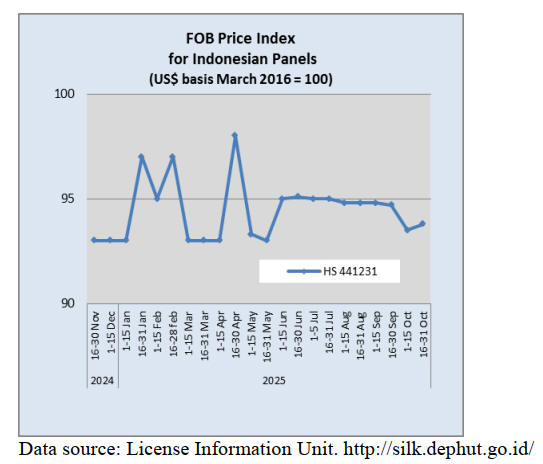
Through the eyes of industry
The latest GTI report lists the challenges identified by the
private sector in Indonesia.
See: https://www.itto-
ggsc.org/static/upload/file/20251022/1761099830162631.pdf
5.
MYANMAR
Central Bank moves to curb inflation
Myanmar’s Central Bank has announced new measures to
withdraw excess liquidity from the banking system in an
effort to control inflation and stabilise the kyat.
In a statement the Central Bank of Myanmar (CBM) said
it will tighten liquidity through two mechanisms. The first
involves increasing the Average Excess Reserve, the funds
commercial banks hold at the central bank beyond
mandatory reserves. The second is interest paid on these
excess reserves will now be adjusted in line with the one-
month average market rate, though the exact rate was not
disclosed.
The central bank attributed the surge in excess liquidity to
the growing use of digital payment systems which has led
to higher bank deposits. However, some economists argue
that expanded money printing by the regime has also
fueled liquidity growth and inflation.
See: https://uniteddaily.my/en/dac7d511-3fc8-413c-9def-
12e62bb5d712
Preparation for ASEAN Economic Community
Myanmar has reviewed its progress in implementing
the ASEAN Economic Community (AEC) Blueprint 2025,
assessing achievements, remaining challenges and
preparations for the next phase of regional economic
integration under ASEAN Vision 2045.
As the AEC 2025 Blueprint enters its final year
discussions focused on Myanmar’s overall implementation
status, future priorities and the transition toward the AEC
Strategic Plan (2026–2030).
The review highlighted that more than 75% of AEC action
lines have been completed with the goal of reaching 90%
by the end of 2025.
Participants discussed how geopolitical and geoeconomic
shifts are shaping ASEAN’s economic landscape. To
strengthen collective resilience, ASEAN has established
the ASEAN Geoeconomics Task Force (AGTF) to provide
policy recommendations and reinforce rules-based,
multilateral cooperation among member states.
The review also emphasised the importance of ASEAN
Vision 2045, which will guide regional cooperation
through four strategic pillars, Political-Security,
Economic, Socio-Cultural, and Connectivity. Within this
framework, the AEC Strategic Plan (2026–2030),
endorsed at the 46th ASEAN Summit will serve as the
first of four consecutive five-year plans driving economic
integration beyond 2025.
Myanmar has kept pace with ASEAN’s evolving
economic goals by established 22 sectoral committees to
oversee AEC implementation each responsible for
advancing commitments across trade, investment, industry
and other key sectors.
See: https://www.gnlm.com.mm/asean-economic-community-
aec-2025-implementation-committees-meeting-held/
ASEAN Summit: Myanmar crisis
Following the recent 47th ASEAN Summit in Malaysia
the regional bloc delivered a decisive but familiar message
on the Myanmar crisis: The Five-Point Consensus (5PC)
remains the only path forward and the planned December
2025 election lacks regional legitimacy. ASEAN leaders
adopted a joint decision reaffirming the Five-Point
Consensus (5PC) as the "main reference" for resolving the
Myanmar crisis.
The ASEAN leaders reiterated their "deep concerns" over
the "lack of substantial progress" in the 5PC's
implementation by the Myanmar authorities nearly four
years after its adoption. ASEAN issued a clear demand:
the "cessation of violence and inclusive political dialogue
must precede elections." In a bid to maintain engagement
the summit reinforced existing diplomatic mechanisms:
ASEAN leaders pledged continued support for the Troika
mechanism (comprising current, past and incoming
ASEAN chairs) and are deliberating a proposal for
a longer-term Special Envoy to ensure sustained
diplomatic engagement.
The leaders reaffirmed the importance of delivering safe
and effective humanitarian assistance without
discrimination, including through cross-border efforts
where necessary, channeled via the ASEAN Coordinating
Centre for Humanitarian Assistance (AHA Centre).
See: https://thediplomat.com/2025/10/asean-foreign-ministers-
voice-concern-about-ongoing-myanmar-conflict/,
and
https://themalaysianreserve.com/2025/10/28/anwar-aseans-
priority-is-to-stop-violence-in-myanmar/#google_vignette
6.
INDIA
Inflation stable
The annual rate of inflation based on the all India
Wholesale Price Index (WPI) was 0.13 in September
(0.52% in August). The positive rate of inflation in
September was primarily due to increase in prices of
manufacture of food products, other manufacturing, non-
food articles, other transport equipment and textiles.
The index for manufacturing increased from 144.9 for
August 2025 to 145.2 in September 2025. Out of the 22
NIC two-digit groups for manufactured products, 10
groups witnessed an increase in prices, 6 groups a
decrease and 6 groups saw no change.
Some of the groups that showed month on month
increased in prices in September were; other
manufacturing, food products, electrical equipment,
textiles and other non-metallic mineral products. Some of
the groups that witnessed a decrease in prices were
manufacture of rubber and plastics products, motor
vehicles, trailers and semi-trailers, pharmaceuticals,
medicinal chemical and botanical products, leather and
related products and printing and reproduction of recorded
media.
The price index for wood panels in September was
unchanged from August. The sawnwood price index tilted
lower while the index for veneers trended higher.
See: https://eaindustry.nic.in/
 
Tariff reduction – a competitive edge in the US
Indian wood product and furniture exporters will become
more competitive in the US market as tariffs on these
products will be reduced from 50% to 10-25% according
to the policy think tank GTRI (Global Trade Research
Initiative, India ).
“For India, the change is a major relief” Ajay Srivastva of
GTRI said, adding that lower tariffs may make India a
cost-effective alternative for US buyers potentially
boosting Indian exports.
The GTRI added that the reduction will significantly
provide respite as India’s exports of affected products
totalled US$654.8 million last year, including US$568.3
million in kitchen cabinets, US$83.3 million in
upholstered furniture and US$3.2 million in softwood
lumber. India’s softwood lumber exports worth US$ 3.2
million will now face a reduced tariff of 10% down from
50%.
See: https://gtri.co.in/gtriFlagshipReportsd.asp?ID=110
and
https://economictimes.indiatimes.com/news/economy/foreign-
trade/indian-wood-and-furniture-exporters-to-gain-competitive-
edge-in-us-after-trumps-10-global-tariff-
gtri/articleshow/124247519.cms?from=mdr
New era of BIS compliancein for woodbased panel
sector
It has been almost six months since the implementation of
new Bureau of Indian Standards (BIS) Standards for the
plywood industry. Plywood manufaturers across the
country are scrambling to obtain a BIS licence but is has
been reported that only 1,000 companies have registered
under new BIS Rules. From 28th August all plywood mills
came under mandatory BIS compliance rules.
In the situation where industry is transitioning to a new set
of regulations there will be major challenges for those
companies that do not fully understand what is involved.
The BIS and industry associations are keen on spreading
awareness about revision to the Standards, particularly the
inclusion of BWP grade in IS:303. The compliance issue
poses a paricular challenge for small size manufactures
and traders.
After initial resistance the plywood and MDF board
industry is now slowly but surely embracing mandatory
quality control norms as they have recognised the long
term benefits of adhering to high quality standards.
See: https://www.plyreporter.com/article/154244/september-
onwards-plywood-panel-industry-is-set-to-witness-new-era-of-
bis-compliance

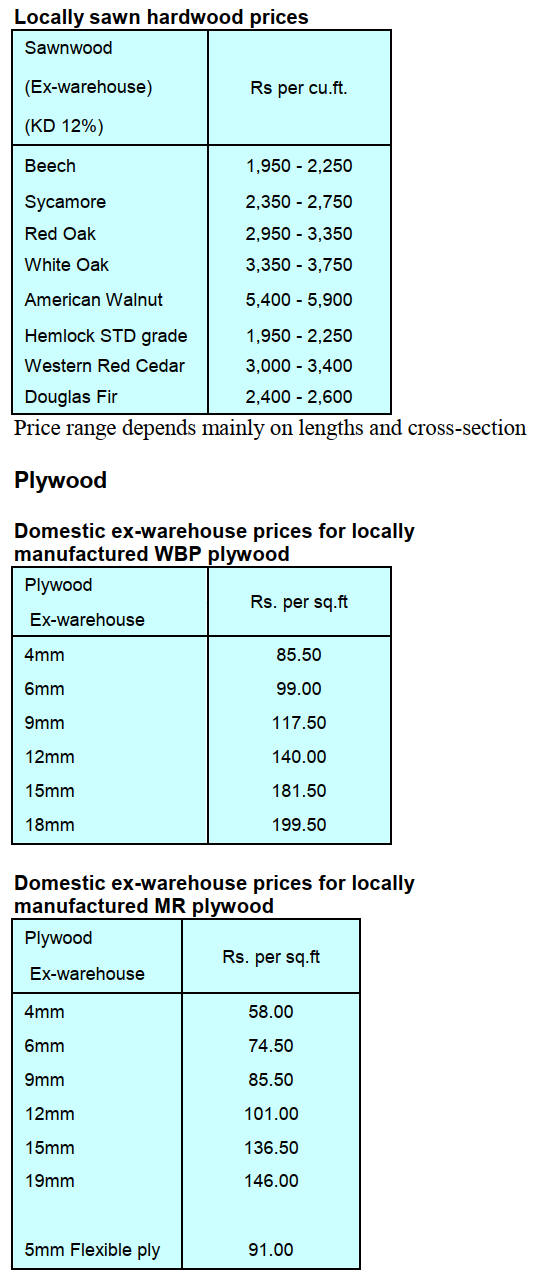
7.
VIETNAM
Wood and Wood Product (W&P) trade
highlights
According to the data from the Viet Nam Customs Office,
W&WP exports to Canada in September 2025 reached
US$24 million, up 14% compared to September 2024. In
the first 9 months of 2025 W&WP exports to the Canadian
market were valued at US$209 million, up 19% over the
same period in 2024.
Viet Nam’s wood pellet exports in September 2025 earned
US$117 million, up 166% compared to September 2024.
In the first 9 months of 2025 the wood pellet exports
earned US$903 million, up 66% over the same period in
2024. This is an impressive growth rate, showing that
demand from traditional markets continues to be stable
and provides an important contribution to Viet Nam’s
W&WP exports.
W&WP imports in September 2025 were at valued
US$260 million, down 10% compared to August 2025.
However, compared to September 2024, imports increased
by 11%. In the first 9 months of 2025, W&WP imports
totalled US$2.37 billion, up 16% in value over the same
period in 2024.
Viet Nam's tali wood imports in September 2025
amounted to US$40,600 cu.m, worth US$16.0 million, up
4% in volume and 5% in value compared to August 2025.
However, compared to September 2024, imports increased
by 54% in volume and 52% in value. In the first 9 months
of 2025, imports of tali were 284,700 cu.m, worth
US$106.4 million, up 24% in volume and 22% in value
compared to 2024.
Viet Nam’s wood industry seeks ways to cope with
tariff challenges
The Vietnamese wood industry is facing significant
challenges in terms of expenses, earnings and the capacity
to sustain exports to important markets as a result of new
US import levies.
The US has imposed high taxes on a variety of imported
wood and furniture products and is anticipated to rise
further in early 2026. In particular, kitchen cabinets,
bathroom cabinets and associated goods will be subject to
tariffs of up to 50% starting in early 2026 - a significant
rise from the initial 25% rate.
A 25% tariff on upholstered furniture (sofas, upholstered
chairs, etc.) went into effect in October and might rise to
roughly 30% by the start of 2026.
Vietnamese wood prices are less competitive than those of
local products in the US and other tax-exempt nations
which has a direct impact on the country's wood industry.
Billions of dollars worth of exports to subject to hefty
taxes
Following the announcement of the increased tax US
clients immediately reduced or canceled orders which had
a direct impact on many export enterprises, particularly
upholstered furniture producers.
FDI companies with factories in Việt Nam are also
concerned about shrinking profit margins as they will have
to reduce prices to preserve market share and split tax
expenses with partners. Businesses were advised to
diversify export markets and cut manufacturing costs
while State assistance such as exemptions and reductions
in land rent, social insurance and logistical costs are of
utmost importance, according to experts.
In the long term, Vietnamese wood product manufactures
should consider shifting to new markets, particularly
Europe and the Middle East with the latter seeing high
demand for furniture products for hotels, resorts and high-
end apartments.
Vũ Quang Huy, Director of the Tekcom Joint Stock
Company, said substantial duties are currently being
applied to various wood products.
Although plywood is not currently subject to the import
tariffs, it is still under an ongoing anti-dumping
investigation. If duties are imposed, the total rate could
reach around 20%. The investigation’s results are expected
to be announced by the end of 2025.
Meanwhile, Nguyễn Ngọc Thanh, General Director of the
Thiên Phát Company, a company that exports kitchen and
bathroom cabinets to the US, predicts that the Vietnamese
wooden furniture industry will encounter numerous
challenges in the future because of the high risk of
additional US investigations.
See: https://wtocenter.vn/su-kien/28873-viet-nams-wood-
industry-seeks-ways-to-cope-with-tariff-
challenges?utm_source=chatgpt.com
HCM City set to become global hub for
wooden furniture production and export
HCM City is poised to become one of the world’s leading
hubs for wood product and furniture production and export
as the global market enters a recovery cycle and demand
for green, sustainable products continues to rise, according
to speakers at a seminar in the city.
The event, titled “HCM City’s Wood and Furniture Export
Industry – A Global Manufacturing and Export Hub,” was
jointly organised by the Handicraft and Wood Industry
Association of HCM City (HAWA), the Viet Nam Timber
and Forest Product Association (Viforest) and the Bình
Dương Furniture Association (BIFA).
Speaking at the event, Phùng Quốc Mẫn, Chairman of
HAWA, said Viet Nam’s wood industry has achieved
remarkable progress over the past two decades, growing
from less than US$200 million in export value in 1999 to
an expected $20 billion by 2025. Viet Nam is now the
world’s second-largest exporter of wooden furniture, just
behind China.
“The industry has built a relatively complete supply chain,
from raw materials and production to distribution, creating
a strong global competitive advantage,” he said.
Following the recent administrative merger of HAWA and
BIFA, HCM City now accounts for nearly half of the
country’s total wood export revenue and has developed an
integrated supply chain covering production, processing,
logistics and seaports. This forms a solid foundation for
the city to position itself as a regional manufacturing hub,
Mẫn added.
HAWA and BIFA are merging, expanding HAWA’s
membership to nearly 1,000 enterprises, about 70%t of
which are producers and exporters.
The new HAWA will work closely with both government
and industry to ensure stable production, sustainable
growth, and global market expansion, aiming to make
HCM City a hub of the world’s wood and furniture
industry.
Nguyễn Quốc Khanh, Chairman of AA Corporation and
Senior Advisor to HAWA, said: "The industry’s goal is
not merely to export but to export profitably and
sustainably."
The wood industry must move beyond subcontracting and
focus on developing value-added products. To achieve
this, businesses need to invest in design, brand
development, marketing and sales channels to enhance
value,” he noted.
He urged local firms to embrace a’ go-global strategy’ by
building their own brands, developing a high-quality
workforce, and adopting ESG-based management models.
“With the right direction, by 2035, HCM City could
achieve US$15 billion in exports, with 80% of products
meeting green standards and forming a smart ecosystem
that integrates industrial, trade promotion, and logistic
hubs across the southern key economic region,” he said.
Nguyễn Liêm, Vice Chairman of Viforest and Chairman
of BIFA, emphasised that the wood industry must pursue
dual transformation - green and digital.
“The green transition helps save energy, reduce emissions
and encourage the use of legal, eco-friendly materials that
meet international standards.
Digital transformation, meanwhile, ensures transparent
management, enables production data measurement,
optimises supply chains and improves demand forecasting.
The two processes are closely linked and go hand in
hand,” he said.
He proposed establishing a Green and Digital
Transformation Support Centre for the wood sector in
HCM city, piloting low-emission factories and green
industrial clusters with shared infrastructure to help small
businesses ‘go green’ at affordable costs.
Lê Đức Nghĩa, Chairman of An Cường Wood Working
JSC, said the company has implemented SAP S/4HANA,
a comprehensive digital management platform, which
integrates production, finance and supply chain data,
boosting productivity by over 20%.
When digital transformation goes hand in hand with green
transition, companies not only save costs but also meet
international standards for transparency, governance and
ESG, all essential for expanding into global markets, he
explained.
He also recommended that the government priorities
digitalising the national wood industry database, build an
open data system, expand access to green finance and
energy-efficient technologies and develop training
programmes to help enterprises comply with international
standards.
Vũ Quang Huy, Chairman of Tekcom, said the industry is
facing trade barriers such as countervailing duty
investigations, traceability requirements and
environmental certification. But these challenges present
an opportunity for businesses with strong capacity and
high compliance standards.
He suggested that HCM city should take a more proactive
role in standardising digital traceability records,
establishing a dedicated centre for HS codes and rules of
origin and developing an early-warning system to prevent
trade fraud.
Thomas Luk, Director of Starwood Furniture of VN Corp,
said many Vietnamese exporters face high US tariffs but
there are ways to mitigate them.
He called for policies to support the renovation of ageing
factories and minimise account receivable risk.
Enterprises at the event further proposed streamlining
administrative procedures and developing a large-scale
trade fair and exhibition centre in HCM City to strengthen
international trade promotion.
In his closing remarks, HCM City People’s Committee
Chairman, Nguyễn Văn Được, praised the achievements of
Viet Nam’s wood and furniture industry, noting that
enterprises are the driving force of economic development.
The city government is committed to listening to and
acting on business feedback. It will turn these ideas into
practical and feasible policies to create a competitive,
transparent and sustainable business environment, he said.
He added that the city would review tax refund
procedures, address overlapping regulations affecting both
domestic and foreign enterprises and continue investing in
road and rail infrastructure to reduce logistics costs.
“With its tradition of dynamism, creativity and pioneering
spirit, I believe HCM City’s wood and furniture business
community will continue to lead the way in realising the
vision of making the city a regional manufacturing and
export hub,” he affirmed.
See: https://vietnamnews.vn/economy/1727961/hcm-city-set-to-
become-global-hub-for-wood-furniture-production-and-
export.html?utm_source=chatgpt.com
Wood industries under growing strain as US tariffs
reshape export dynamics
Ngo Si Hoai, Vice Chairman and Secretary General of the
Viet Nam Timber and Forest Products Association, says
the US decision on tariffs will significantly affect
Vietnamese wood product exports, leaving companies
little room to adjust in the short term.
He notes that, with the US accounting for more than half
of Viet Nam’s total wood product export value, many
enterprises may have to reconsider their strategies if tariffs
rise further.
Nguyen Phuong, Vice Chairman of the Dong Nai Wood
and Handicrafts Association, warns that export
performance may decline in the final months of 2025
depending on tariff developments. He calls for greater
government support through market intelligence, risk
assessment and more proactive trade policy responses to
help firms adapt to external shocks.
In addition, Nguyen Chanh Phuong, Vice Chairman of the
Handicraft and Wood Industry Association of Ho Chi
Minh City (HAWA), said that the sector’s long-term
sustainability depends on improving production autonomy,
developing skilled labour and ensuring legal raw material
sources.
He stressed that Vietnamese businesses should move
beyond contract manufacturing and focus on brand
building and professional design to strengthen their global
position.
See: https://the-shiv.com/wood-industry-in-vietnam-under-
growing-strain-as-new-us-tariffs-reshape-export-
dynamics/#utm_source=chatgpt.com
8. BRAZIL
BNDES initiative on native timber species
The Brazilian Development Bank (BNDES) has launched
the BNDES Forest Innovation Programme (Floresta
Inovação programs) aiming to position Brazil as a leader
in the international tropical timber market. The
programme was launched with an investment of R$24.9
million in a project focused on innovation in the
silviculture of planted native timber species
The project, approved by BNDES, was proposed by the
Steering Committee of the Research and Development
Program on the Silviculture of Native Species
(PPD&SEN, created by the Brazilian Coalition on
Climate, Forests and Agriculture in 2021. Its goal is to
develop and disseminate technological innovations to
expand the silviculture of native species following the
successful example of eucalyptus cultivation.
According to BNDES, tropical timber production in Brazil
currently comes mainly from natural forests and
expanding native species silviculture could complement
sustainable management in forest concessions.
The innovative project in silviculture covers five research
areas, seed and seedlings, genetic improvement, vegetative
propagation, forest management and wood technology
encompassing 30 native species from the Amazon and
Atlantic Forest biomes. It includes 20 research sites,
totalling around 160 hectares of new plantations along
with six existing areas that will serve as reference hubs.
With five-year duration, the project marks the first phase
of the programme that could extend to up to 30 years
aiming to develop improved clones, germination
protocols, optimised regional production systems and new
technological applications.
The Federal University of São Carlos (UFSCar) will
coordinate activities in the Atlantic Forest, while Embrapa
Amazônia Oriental and Embrapa Forestry will lead efforts
in the Amazon. The initiative is part of the BNDES
Florestas program which supports bioeconomy and
productive ecological restoration with the goal of restoring
6 million hectares by 2030 and 24 million hectares by
2050 transforming the current “Deforestation Arc” into a
corridor for restoration and sustainable forest production.
See:
https://agenciadenoticias.bndes.gov.br/socioambiental/BNDES-
lanca-iniciativa-para-impulsionar-mercado-de-floresta-tropical-
com-apoio-a-silvicultura-de-especies-nativas
Innovation and development in the Amazon
A feasibility study for the implementation of Innovation
Hubs in the Pan-Amazon Region, coordinated by the
Amazonia 4.0 Institute, identified significant economic
and socio-environmental potential in the Amazon region
with the capacity to generate up to R$8.3 billion per year
in added value and around 620,000 ‘green’ jobs by 2035.
The initiative aims to make the Amazon bioeconomy into
a strategic driver of sustainable development, adding value
to biodiversity products and promoting the inclusion of
local communities.
The study proposes solutions such as an Intelligent River
Logistics Platform, expected to cut logistics costs by up to
40%, reduced post-harvest losses by 25%, and
decarbonising 1.8 million tonnes of CO2 annually through
sustainable transport modes.
It also highlights structural bottlenecks in the states of
Amazonas, Pará and Amapá, including low value addition
to natural products, limited R&D infrastructure,
concentration of innovation in capitals and lack of
integrated governance among government, academia and
industry.
The proposed model envisions innovation hubs organised
into three integrated centres: (i) technological, focused on
research, development and prototyping; (ii)
entrepreneurial, with incubators, accelerators and
coworking spaces; and (iii) community-based, for training
and social integration of riverside, Indigenous and
extractivist communities.
The priority locations include Macapá, Santana, Santarém,
Marajó, Manacapuru, Tefé, Marabá, and Xinguara in the
Amazon region.
The initiative aligns with the National Bioeconomy Plan
and World Bank targets to triple Amazon’s GDP by 2035
to around R$700 billion per year. It establishes a strategic
framework for strengthening the Amazon bioeconomy,
combining technological innovation, environmental
sustainability and inclusive territorial development, while
paving the way for new energy and biomass studies as
levers for sustainable growth in the region.
See: https://www.maisfloresta.com.br/hubs-de-inovacao-na-
amazonia-podem-gerar-mais-de-r-8-bi-por-ano/
Export update
In September 2025, Brazilian exports of wood-based
products (except pulp and paper) decreased 31% in value
compared to September 2024, from US$313.7 million to
US$217.8 million.
Pine sawnwood exports increased 0.2% in value between
September 2024 (US$45.3 million) and September 2025
(US$45.4 million). In volume, exports increased 9% over
the same period, from 191,000 cu.m to 207,700 cu.m.
Tropical sawnwood exports increased 11% in volume,
from 25,700 cu.m in September 2024 to 28,600 cu.m in
September 2025. In value, exports increased 21% from
US$10.0 million to US$12.1 million, over the same
period.
Pine plywood exports decreased 40% in value in
September 2025 compared to September 2024, from
US$68.2 million to US$41.0 million. In volume, exports
decreased 36% over the same period, from 202,900 cu.m
to 130,700 cu.m.
As for tropical plywood, exports increased in volume (4%)
and in value (6%) from 2,700 cu.m and US$1.6 million in
September 2024 to 1,700 cu.m and US$2.8 million in
September 2025, respectively.
The value of wooden furniture exports decreased from
US$51.0 million in September 2024 to US$47.1 million in
September 2025, a decrease of 8%%.
State of Pará registers highest annual timber exports
The timber sector of the State of Pará recorded its best
export performance of the year in September 2025
reaching US$28.9 million and 25,000 tonnes of wood
products and by-products according to the Association of
Wood Exporting Industries of the State of Pará (Aimex).
Compared to August, exports grew 98% in value and 44%
in volume, with the highest average price of the year (US$
1,125.44/tonne).
Between January to September 2025 exports totalled
US$163.9 million and 203,600 tonnes, up 0.43% in value
and 7% in volume compared to the same period in 2024.
The main exported products, flooring, decking, parquet,
moldings and sawnwood, accounted for 82% of total
exports keeping Pará as Brazil´s fourth-largest wood
exporter in Brazil, behind only Santa Catarina, Paraná, and
Rio Grande do Sul.
The United States remained the top destination, importing
US$67 million driven by the housing market following the
recent interest rate cut in the US.
Despite the positive results, Aimex pointed out operational
bottlenecks, notably the lack of integration between Pará’s
control system and IBAMA´s National System for the
Control of the Origin of Forest Products (Sinaflor).
The association Aimex emphasised the sector´s resilience
amid bureaucratic barriers, exchange rate volatility and
growing international demand, highlighting the need to
improve environmental control and export clearance
mechanisms to balance sustainability and competitiveness.
See: https://www.diarioro.com.br/2025/10/20/exportacoes-de-
madeira-do-para-crescem-em-setembro-e-alcancam-melhor-
desempenho-do-ano-aponta-aimex
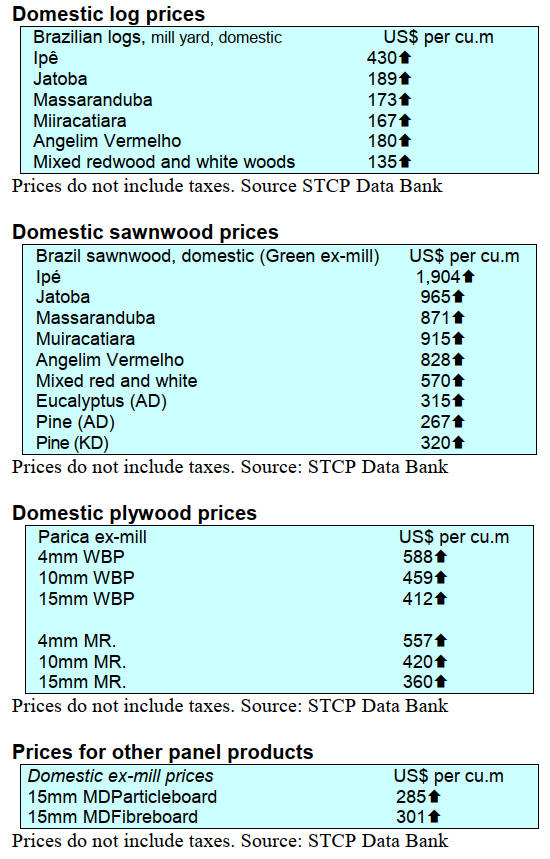
Export prices
Average FOB prices Belém/PA, Paranaguá/PR,
Navegantes/SC and Itajaí/SC Ports.
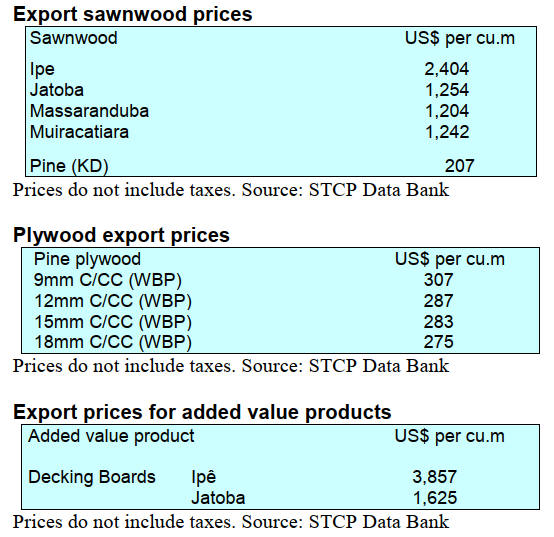
Through the eyes of industry
The latest GTI report lists the challenges identified by the
private sector in Brazil.
See: https://www.itto-
ggsc.org/static/upload/file/20251022/1761099830162631.pdf
9. PERU
A disappointing first 8 months, exports down more
than 20%
Shipments of wood products totalled US$42.7 million
during the first eight months of 2025, a decrease of over
20% compared to the same month in 2024 according to the
Center for Global Economy and Business Research of the
CIEN-ADEX Exporters Association.
According to figures from the ADEX Data Trade
Intelligence System, exports included sawnwood
(US$16.2 million), semi-manufactured products (US$14.2
million), firewood and charcoal (US$4.1 million),
furniture and parts (US$2.8 million) and construction
products (US$2.6 million).
The leading destination was the Dominican Republic, with
shipments totalling US$7.8 million, an increase of about
8% compared to the previous year. The United States
followed with US$6.2 million, (-28% compared to the
same period in 2024), France (US$6.1 million a drop of
34%), China (US$4.5 million, a decrease of 38%) and
rounding out the Top 5 destinations was Mexico with sales
of US$4.1 million, a decrease of 34% year on year.
Veneer and plywood exports declined January to
August 2025
According to information provided by the Services and
Extractive Industries Department of the Association of
Exporters (ADEX), veneer and plywood shipments during
the January-August 2025 period reached an FOB export
value of US$1.7 million, down around 7% year on year.
The main export market for these products was Mexico
which accounted for a 43% share but over the period in
question there was a 52% decline compared to the same
period in 2024. Ecuador followed with a 32% share and in
third place was Colombia with 12% share followed by the
Dominican Republic 9% and Costa Rica 4%.
International consults to assess prospects for
commercial forest plantations
The National Forest and Wildlife Service (SERFOR)
received representative of the consulting firm UNIQUE
Land Use GmbH to exchange information and deepen
technical and financial analysis related to the development
of commercial forest plantations.
The meeting provided an opportunity to exchange of
knowledge, the presentation of international experiences
and the development of a framework for a roadmap aimed
at more efficient and sustainable management of the
country's forest resources.
Leif Nutto, senior consultant at UNIQUE, highlighted the
need to work together to ensure that producers, investors
and public sector representatives can exchange ideas,
needs and opportunities to strengthen the forest value
chain.
See: https://www.gob.pe/institucion/serfor/noticias/1271155-
midagri-serfor-recibio-a-consultora-internacional-del-banco-
mundial-para-promover-plantaciones-forestales-comerciales
Training on investment mechanisms available for the
forestry sector
More than 200 authorities and public officials were trained
in collaborative investment mechanisms so they can access
the more than US$12 billion in competitive funds offered
by the Peruvian government for the forestry sector and
other development projects.
The event was organised by the National Forestry and
Wildlife Service (SEFOR) under its Sustainable
Productive Forests Programme (BPS). "Sustainable forest
development begins in the regions. That's why we
strengthen the capacities of regional and local
governments," said the BPS executive coordinator.
See: https://www.gob.pe/institucion/serfor/noticias/1264796-
serfor-capacita-a-mas-de-200-autoridades-en-mecanismos-de-
inversion-disponibles-en-el-sector-forestal
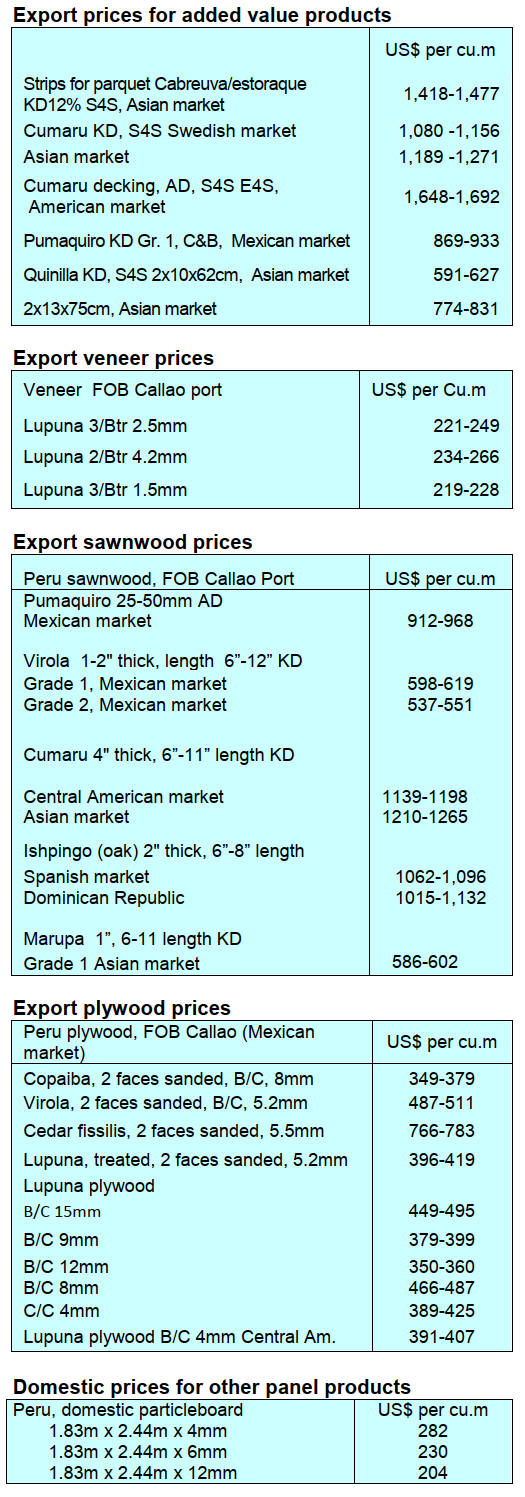
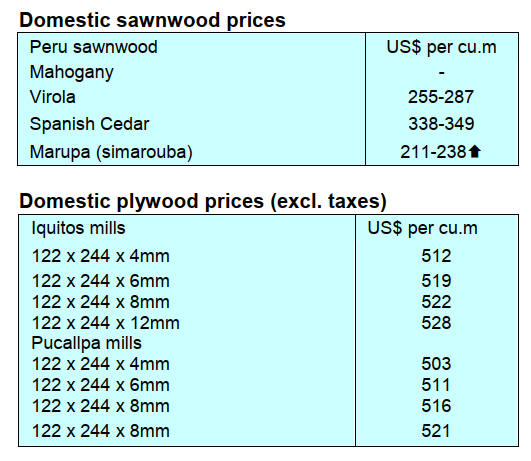
|